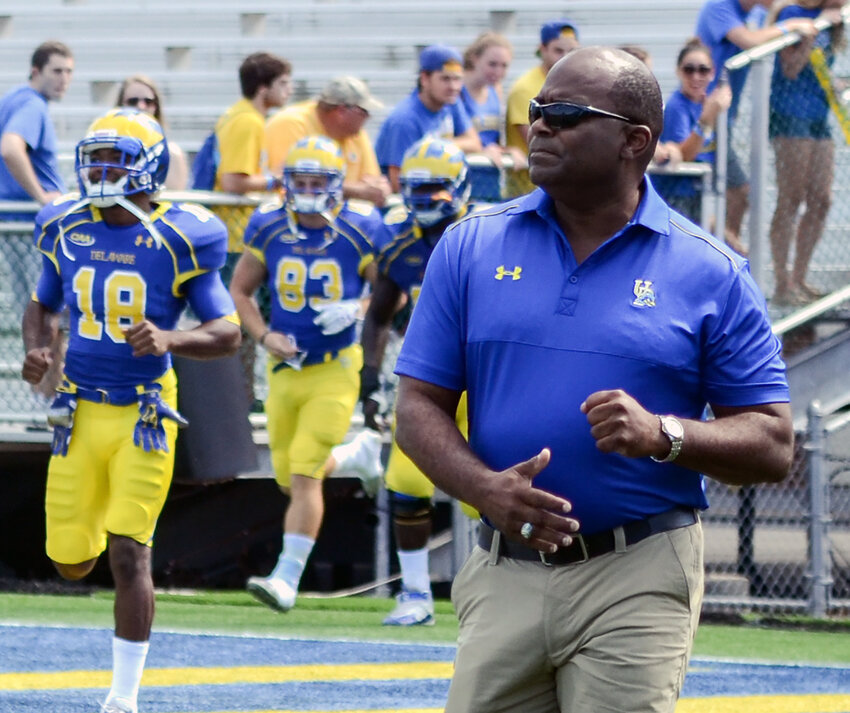DIAA ready to move forward after changes approved
DOVER — Change, said Dave Baylor, can often be a good thing.
Making things better often begins with trying new solutions to old problems.
“I think when you have change, you have …

You must be a member to read this story.
Join our family of readers for as little as $5 per month and support local, unbiased journalism.
Already a member? Log in to continue. Otherwise, follow the link below to join.
Please log in to continue |
DIAA ready to move forward after changes approved
DOVER — Change, said Dave Baylor, can often be a good thing.
Making things better often begins with trying new solutions to old problems.
“I think when you have change, you have the opportunity .... to have different sets of eyes look at how you do things,” said Baylor.
The organization that Baylor heads — the Delaware Interscholastic Athletic Association — is facing some fairly big changes right now.
Those changes are part of bills passed by the Delaware Legislature in its session that ended last Sunday.
The moves were the recommendations of a state task force that met over the course of eight months to study how to make the DIAA more efficient.
Probably the most noticeable difference will be in the makeup of the DIAA board of directors, which will go from a 22-member group to a 15-person one (plus two non-voting members).
The board of directors will no longer have to deal with eligibility waivers for student-athletes. The hope is that will free it to delve more into the issues that high school athletics are dealing with.
New regulations that will allow the board and/or executive director to bypass red tape are also expected to speed up the process.
New transfer rules
But Baylor believes that the DIAA’s new transfer regulations may have the biggest impact.
While student-athletes can still transfer once without penalty up to the start of their junior year, they will now have to sit out 30 competition days at their new school if they transfer after that.
Also, if a transfer is the student-athlete’s second move, they will then be ineligible to play in the state tournament that season. There are exceptions for specific situations.
Baylor, however, thinks the regulation will discourage student-athletes from transferring for athletic purposes.
“It really changes the landscape on how you can transfer,” he said. “In the long term, I don’t think you’re going to have these student-athletes jumping from school to school. I think the competitive balance will start to neutralize itself.
“You won’t be able to do that (transfer) in your junior and senior year without having to sit out a state championship.”
Baylor said that rule goes into effect as soon as Gov. John Carney signs it into law, perhaps by the middle of this month.
The changes in the DIAA’s transfer policy are big enough that Baylor is hoping to hold seminars in each of the state’s three counties explaining the regulation. He’s planning on having sessions for both school officials and coaches as well as student-athletes and their families.
Student-athletes can still apply for a waiver to transfer. But if it is determined that the move is to gain a competitive advantage, the student-athlete will be ineligible.
Waiver requests will now be handled by the DIAA executive director.
More staff, more time
The DIAA, which has had only a three-person full-time staff, is also adding three positions which will deal specifically with finances, rules compliance and communications.
Baylor said those positions are already being advertised.
The belief is that DIAA board meetings will become more productive said Baylor.
“Now that they’re out of the business of dealing with waivers, it’s going to make the board meetings more focused on things that will be able to benefit the DIAA,” he said, “whether it’s changing some regulations to make us more up to date compared to our colleagues in other states or whether it’s addressing more issues that are timely.”
One of those issues is studying whether Delaware’s state tournaments should be split between public and private schools — a request that the state legislature made via a resolution.
“Now we can get down to the business of being able to do things that are going to better student-athletes,” said Baylor. “We can make competition better, make championships better and serve our schools and members better because we won’t be mired down in waiver hearings.”
The people making up the DIAA’s new board of directors will definitely change.
The 15-person board will now include one principal from each county; a non-public head of school; the president of the Delaware Chief School Officers Association; four athletic directors representing each county and a non-public school; a sports medicine professional; a mental or behavioral health specialist; an athletic trainer; and three public members.
The athletic directors of both the University of Delaware and Delaware State will also become non-voting members.
Moving ahead
Until the new board is in place, Baylor believes the current board members will continue fulfilling their obligations to the DIAA.
“I think because the board has been around for a while, I think we can still continue to effectively move the mission of the DIAA and then have a smooth transition to the new board when that occurs,” he said.
When it’s all said and done, Baylor is optimistic that all these changes will make the DIAA — and thus high school sports in the state — will be better off.
He’s just finished his first year as the DIAA’s executive director.
“I’m excited about fresh ideas,” said Baylor. “Different energy. Because no matter where you are, whether it’s this board or the board at DuPont, if you don’t have change, you become stagnant.”


 By
By 




